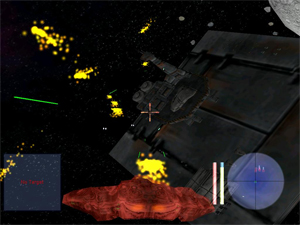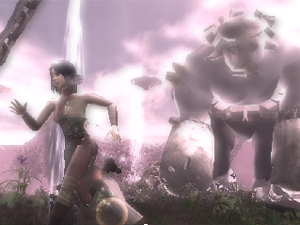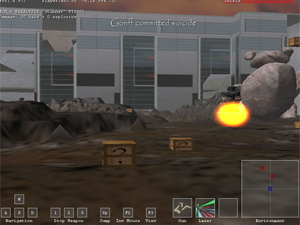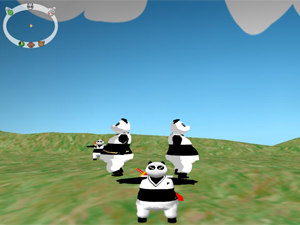Calit2 at UCSD Hosts Undergraduate Computer Game Software Finals
San Diego, CA, August 14, 2006 -- As the 2005-'06 academic year drew to a close, students enrolled in a Computer Science and Engineering course flocked to the Calit2 auditorium at UCSD to showcase the computer games they designed over the course of the previous ten weeks. And they did so, to a packed house.
|
Streaming video clips of each team's presentation and game demo can be viewed by clicking on the image or game title at right [Real player and broadband connection required].
The goal of CSE 125 is to experience the design and implementation of a large, complex software system in large groups. To make the class exciting as well as challenging, each team was charged with creating a distributed, real-time, 3D, multiplayer game of their own design.
According to CSE professor Geoff Voelker, emphasis is placed on the development process itself in addition to the final product. The groups decided on the features of their projects, specified any requirements, created a design and implementation schedule, implemented it, and gave the public demonstration before a packed audience at Calit2.
The final presentations and demos took place on June 9.
A team calling itself Ludicrous Speed produced the game NightSky. "We started out wanting to do a space combat game with big ships, lots of guns and lots of asteroids," reports the team on its final project website. "We finished with a space combat with big ships, lots of guns, and not as many asteroids, but a really cool waste facility structure. We found that the asteroids did not add as much to the gameplay as we originally anticipated."
The NightSky designers also noted that they "got so many good suggestions from people after the game demonstration that would have saved an immense amount of time and made a better game had they been suggested five or ten weeks earlier."
TEAM-WTF designed the anime-style "Petals of Pandora" as a third-person adventure game, with four 20-somethings going up against a hulking monster called the Apocalypse Machine in a surreal setting where parts of the land are floating. According to the team's story line, the game features "a full environment that will allow the players to feel immersed in this post-apocalyptic, eco-loving world." All the art in the game is original and stunned the audience at the public demo. The musical score was also an original composition. The graphics techniques employed by the team included tone mapping, pseudo light-scattering, bump mapping, specular mapping and other techniques.
The team behind UCSDOOM opted for a first-person shooter game located on the UCSD campus. "We had a post-apocalyptic UCSD, players fighting each other with combinatorial weapons (all 20 of them), and it was all packaged in a fun, relatively stable game," notes the team's final project review. Littered throughout the environment are various weapons --- including machine guns, rocket launchers, laser pulse rifles -- which players can pick up and use.
After the course, professor Voelker asked teams to provide input on how to improve the course, along with their advice for students who take CSE 125 in Spring 2007. The UCSDOOM designers' best advice for future students: "Start and test early (hopefully in modular fashion). Additionally, we found it helpful to have integration done as soon as possible... Once those parts are done, things start moving and looking really cool really fast." According to Jim Hong, co-creator of Kablooey!, "my advice is to get everyone to work in the lab so everyone can learn off each other... Definitely program with most of your members there, so everyone knows that's happening in the game."
Among other suggestions from the various teams: "Maybe be more aggressive in recruiting ICAM majors. I think it would have been interesting to have worked with some non-CSE people."; "In addition to having guest speakers, bring in experts to the lab to look at what the students have currently completed and give them suggestions for improvement."; "More food in the lab, and bring the X-Box back!"
Related Links
CSE125 Spring 2006
CSE125 Introductory Presentation
CSE125 Media and Coverage




